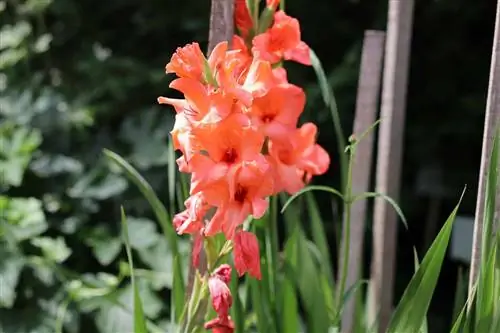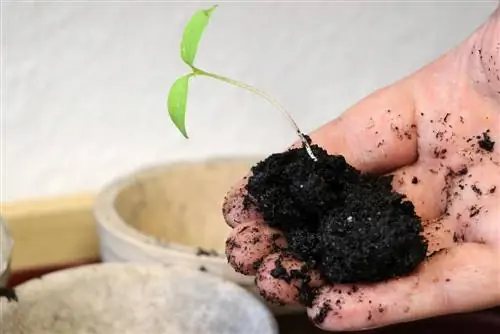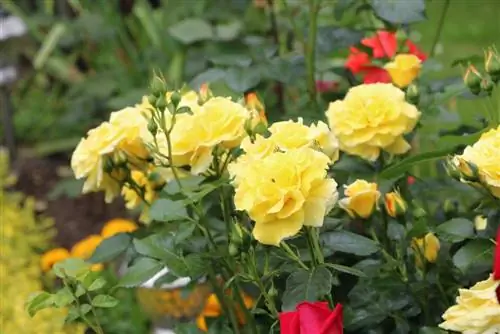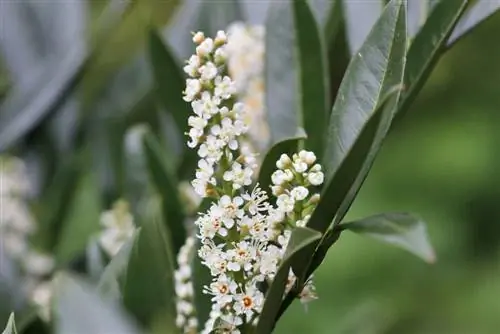- Author admin [email protected].
- Public 2023-12-17 03:39.
- Last modified 2025-06-01 06:48.
Planting gladioli - when is the best time to plant? Gladioli, which belong to the iris family, are primarily ornamental plants and are popular both in the garden and as cut flowers in tall vases. Gladiolus are available in a wide variety of varieties and colors and are generally considered a tall plant variety - they can reach heights of up to 150cm. These popular and colorfully flowering plants are relatively easy to care for and if you follow the following care tips, they will quickly enrich any ornamental garden!
The best planting time
Generally speaking, gladioli like it warm and are therefore planted in spring/summer. April is considered the main planting time for most gladiolus varieties. The main flowering time of gladioli is from June to September.
Many varieties can be planted until summer (around April - June).
Important: if there is still a risk of night frosts in April, you should definitely wait until May or June before planting - gladioli are very sensitive to cold and both the bulbs and the plants should under no circumstances be exposed to frost become.
Since the flowering period of gladioli is in many cases very short (around 2 weeks), there is the possibility of visually extending it in the bed by planting various early, medium early and late flowering varieties. If necessary, this follow-up planting can take place until July.
Wild forms of gladioli (such as the Siegwurz varieties) can also be planted in the garden. They usually grow lower than the noble varieties and are not as sensitive. They can therefore be placed as early as October.
More care tips: location and planting
Gladiolus should be planted in a protected and sunny location.
The soil should be nutrient-rich and water-permeable. The soil can be supplied with nutrients using humus or compost before planting gladioli.
The soil should always be kept moist, but waterlogging should be avoided.
The gladiolus bulbs should be planted approximately 10cm deep in the soil, in groups or rows with a planting distance of approximately 15cm. It is recommended to plant the same varieties together.
The higher and wider the plant ultimately grows, the more space it should have in the soil. For very tall growing varieties, planting depth and planting distance should be increased by a few centimeters.
Low-growing (wild) varieties can therefore be planted a little closer to each other and do not have to be planted as deeply into the soil (approx. 6-8cm planting depth and approx. 10cm planting distance).
In sandy or very loose soils, the bulbs of tall gladiolus varieties should generally be planted a little deeper to give them enough stability. In addition, the stems can be tied to fixed rods if necessary.
Care during the flowering period
As already mentioned, the soil should always be kept moist, but never too wet.
Gladiolus do not need to be fertilized; They should also not be planted in freshly fertilized soil.
Flower stems should be cut off after flowering to prevent the bulbs from being weakened by seed formation. Of course, individual flower stems can also be cut off during flowering to be used as cut flowers in the vase.
However, not too many flowers should be cut during the growing season if the plant's tuber is to be overwintered in order to produce a magnificently blooming gladiolus again next year.
After the flowering period: Gladiolus overwinter successfully
Since the nobler varieties of gladioli, as already mentioned, do not like frost and are not hardy, the bulbs have to be moved indoors to overwinter.
To do this, the plants are removed from the ground after they have faded by the beginning of October at the latest, but in any case before the first frost.
The remains of the inflorescence are cut off about 5 to 10cm above the tuber.
The tubers should be checked for pests and rot before storing.
The tubers must then be dried - they must not become damp and rot during the winter. Wrapped in newspaper, they can be stored in the cellar, for example, and should under no circumstances come into contact with frost.
Some wild forms of gladioli are moderately hardy and do not need to be overwintered - however, they do require winter protection (e.g. dry leaves).
Propagation of gladioli
It can happen that brood tubers form on the tubers in summer. These can be removed after the excavation in the fall and left over the winter. In spring they are then planted on a seedbed to grow new gladioli.
Pest Control
Gladiolus plants and flowers can be attacked by the so-called gladiolus bladder foot (“thrips”). It can be recognized by whitish-gray spots on the leaves that gradually spread. The flowers can also be affected: dry and bleached areas appear on the edges and tips when infested, and in severe cases the flowers become crippled.
If the gladiolus blister foot is infested, affected areas can be cut off to prevent its spread.
After excavation in autumn, both the bulbs of he althy and infected plants should be checked: if no pest infestation can be seen on the tuber, the rest of the inflorescence can also be cut off from pest-plagued plants in order to successfully protect the tubers to overwinter. However, tubers that are already infected should be disposed of.
The gladioli can also be attacked by other fungal diseases; Pruning prevents their spread; in more stubborn cases, the plants may need to be treated with fungicides.
If you take the few but important requirements of this beautiful and popular plant into account when caring for gladiolus, you will be able to enjoy its abundance and color for a long time! Well-cared for gladiolus bulbs can be released every year for years to enrich flower and ornamental beds regularly in summer!
Planting time for gladiolus tubers
Gladiolus are planted as tubers, the best planting time is from mid-April to the end of May or early June. If the tubers are to be dug up again in the fall and overwintered, it is advisable to plant them in April so that the plant still has enough time after flowering to store nutrients in its tuber for the winter and the next year.
Planting gladioli
Gladiolus tubers are planted in soil that is as nutrient-rich and loose as possible, which should always be kept slightly moist. A sheltered location with direct sun is best. The tuber is placed about 10 centimeters into the ground with the flat side down and covered with soil. In very light soil, the tuber can also be planted a little deeper so that it has the necessary support later. Several tubers need a distance of around 20 centimeters from one another. Especially the varieties that grow very tall should have a support for their flower stem so that they don't bend over later.
Overwintering gladioli
Gladiolus tubers are not hardy and must therefore be removed from the ground in autumn when their leaves have already grown. The soil, dead parts and the remains of the leaves should be carefully removed. To dry thoroughly, the tubers are best laid out outdoors in good weather. They can then be stored in a wooden box or cardboard box in a dark and airy room with a maximum temperature of 15° C until spring. During the winter and also before replanting, rotten and moldy tubers are sorted out. Gladioli must not be planted in the same place as last year, otherwise they will become lazy to bloom.
Gladiolus as cut flowers
In order to use the gladioli from the garden as flower decorations in the home, they should be cut when the first flower opens on an inflorescence. Then all the other flowers will gradually open in the vase. To ensure a longer shelf life, when cutting, make sure that as many leaves as possible remain on the stem. If a flower stalk is cut off directly at the ground, the tuber can no longer be formed as well, so new tubers may have to be bought for the next year. Even for varieties that only bloom in September or later, it is usually not worth saving the tubers.






